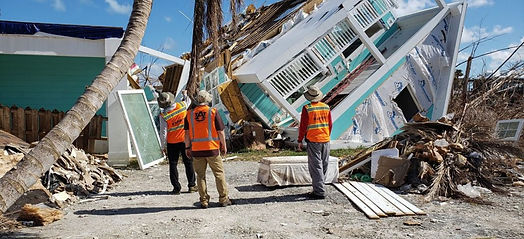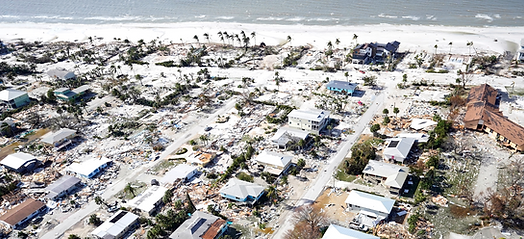
NICHE
Research Agenda
NICHE's users will undoubtedly diversify the facility's research areas over time, but the initial NICHE Science Plan anticipates the following high-priority areas that require the immediate attention of the natural hazards research community to accurately model and discern actionable response plans.
RESEARCH AREA 1: Modeling Impacts of Atmospheric Events on Communities to Build a Safer America

Credit: StEER
-
What are the impacts of atmospheric events including single, cascading, and co-occurring hazards (wind, surge, wave, and flood) on coastal and inland buildings and infrastructure?
-
How to address the knowledge gaps in building resilience in vulnerable communities to enhance safety of U.S. citizens and harden critical infrastructure and buildings against natural hazards?
-
How can we conduct fusion of measured and computational data to generate, calibrate, and validate efficient surrogate simulation of hazard impacts via Artificial Intelligence (AI) and Machine Learning (ML) as part of digital twin research effort?
-
What advances are needed to improve coupled wind-water hazard impact modeling of individual structure to community to regional scales, including systematic interdependence in building inventories, networked infrastructure, rapid return to functionality, and socio-economic systems?
-
What are the uplift loads due to wind and waves on elevated structures (e.g., houses on stilts), that, despite being one of the most common structural archetypes near the coast, do not have existing guidelines in codes and standards for estimating these uplift forces?
-
How can the performance of aging infrastructure systems (such as telecommunications, electric power systems, natural gas and oil, transportation, and water supply systems) be evaluated to increase their resilience under wind/water actions and debris dynamics?
RESEARCH AREA 2: Modeling Coastal Processes and Protective Systems under Interacting Hazards for More Resilient U.S. Coastal Regions

Credit: GCM Contracting Solutions
-
How are coastal vulnerabilities affected by sediment transport, erosion, nearshore and onshore morphodynamics and geomechanics under the impacts of combined wind-surge-wave actions?
-
How to evaluate the most efficient natural (e.g., live mangroves, dune vegetation, salt marshes, coral reefs) and constructed (e.g., sea walls, levees, flood protection systems) protective systems that can contribute to a Stronger and More Resilient and Prosperous America?
-
How does hybrid (natural-constructed) coastal protection perform and how do the components interact (as there is no guidance on designing a hybrid protection system)?
-
What solutions are most effective to ensure the stability of coastal structures and their foundations impacted by groundwater processes, wind-wave dynamics, nearshore and onshore morpho-dynamics, geomechanics, sediment transport, and erosion?
-
What technologies would best mitigate the impacts of wind, surge, waves, and current on the scour and stability of underwater cables, pipelines, and sewer pipes?
-
How do individual and compounding water and wind hazards affect the ecology and physical dynamics of coastal and estuarine processes including tides, turbulence, upwelling, stratification, and transport?
-
What is the role of vegetation in sediment transport and deposition and how to quantify settling velocity due to flocculation dominated by bio-cohesion in a marsh region?
-
What processes are associated with breaking waves and entrapped air interaction with structural components, and how do these processes affect the fragility of coastal structures?
-
How do groundwater processes and geomechanics influence wave dynamics, coastal morphodynamics, and erosion at different shoreline types (e.g., cobble beaches and rocky bluffs)?
RESEARCH AREA 3: Mitigating Escalating Losses from Natural Hazards and Promoting Resilient Recovery

Credit: NOAA
-
How should stakeholders be engaged and translation pathways be primed to foster more expeditious uptake of scientific findings that increase community resilience, reduce property damage, and save lives?
-
What new strategies can build resilience in vulnerable areas and enhance safety of U.S. citizens by reducing wind and/or water impacts (e.g., structural failure, non-structural damage, scouring of foundation, corrosion) on critical infrastructure and buildings?
-
How to deliver high return on investment (ROI) through technology transfer and proactive mitigation implementation at community or regional scales?
-
How can research outcomes be used to enhance risk forecasting and assessment models, validate vulnerability and fragility functions, and improve benefit-cost analysis?
-
How can findings be used to help design insurance products and regulatory tools that adequately cover the associated risk with wind and flood hazards?
-
What new strategies can be developed to differentiate water damage versus wind damage impacts on commercial and residential properties to reduce insurance disputes and litigations?